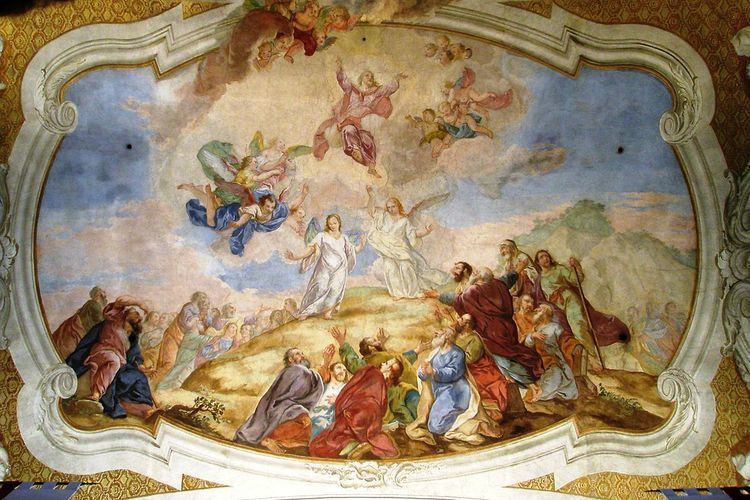Chorale Johann Rist | Cantata text anonymous | |
 | ||
Movements 11 in two parts (5 + 6) Bible text Psalms 47:5–7Mark 16:14–20 | ||
Gott fähret auf mit Jauchzen ("God goes up with jubilation" or "God has gone up with a shout"), BWV 43, is a church cantata by Johann Sebastian Bach. He composed it in Leipzig for the Feast of the Ascension and first performed it on 30 May 1726.
Contents
History and words
Bach composed the cantata in his third year in Leipzig for the feast of Ascension. The prescribed readings for the feast day were from the Acts of the Apostles, the prologue and Ascension (Acts 1:1–11), and from the Gospel of Mark, Jesus telling his disciples to preach and baptise, and his Ascension (Mark 16:14–20).
The text of the cantata is unusual as it consists mostly of a poem in six stanzas, which forms movements 5 to 10 of the work in 11 movements. The structure is similar to that of cantatas by Bach's cousin Johann Ludwig Bach, court conductor in Meiningen, that Bach performed during 1726: Old Testament quotation, recitative, aria, New Testament quotation, poem, chorale. The first quotation is taken from Psalm 47 (Psalms 47:5–7) and is traditionally understood as a reference to the Ascension. The other quotation in movement 4 is verse 19 from the gospel. An unknown poet paraphrased in recitative and aria an idea from Psalm 68 (Psalms 68:18) as well as its quotation in the Epistle to the Ephesians (Ephesians 4:8), "when he ascended up on high, he led captivity captive". In movement 7 he used the motif of Christ in the winepress.
The cantata is closed by the first and thirteenth stanza of Johann Rist's hymn "Du Lebensfürst, Herr Jesu Christ" (1641). Bach would later use stanza four of the chorale for his Ascension Oratorio. The cantata consists of two parts, to be performed before and after the sermon. Bach first performed it on 30 May 1726.
Scoring and structure
The cantata is festively scored for four vocal soloists (soprano, alto, tenor and bass), a four-part choir, three trumpets, timpani (tamburi in the autograph), two oboes, two violins, viola and basso continuo.
- Chorus: Gott fähret auf mit Jauchzen
- Recitative (tenor): Es will der Höchste sich ein Siegsgepräng bereiten
- Aria (tenor): Ja tausendmal tausend begleiten den Wagen
- Recitative (soprano): Und der Herr, nachdem er mit ihnen geredet hatte
- Aria (soprano): Mein Jesus hat nunmehr
- Recitative (bass): Es kommt der Helden Held
- Aria (bass): Er ists, der ganz allein
- Recitative (alto): Der Vater hat ihm ja
- Aria (alto): Ich sehe schon im Geist
- Recitative (soprano): Er will mir neben sich
- Chorale: Du Lebensfürst, Herr Jesu Christ
Music
The opening chorus with the full orchestra is the "centre of gravity" of the cantata. It opens with an introduction marked "adagio", played by the strings doubled by the oboes. Then a fugue begins, two instrumental entries are followed by choral entries, a climax is reached in an entry of the first trumpet. A second fugue includes remote and minor keys. The second part of the text, "lobsinget Gott, lobsinget unserm Könige" (sing praises to God, sing praises unto our King) is first sung in homophony, but then presented in a third fugue on the theme of the first, followed by a homophonic coda. A secco recitative leads to the first aria, accompanied by the violins in unison. The complete text is sung three times in different sections. The New Testament quotation is sung not by the bass as the vox Christi but, likely because Jesus is not speaking himself, instead the soprano narrates "So then after the Lord had spoken unto them, he was received up into heaven, and sat on the right hand of God" as a secco recitative. Movement 5 concludes Part I and is based on the first stanza of the poem. The soprano is accompanied by the strings, doubled by the oboes. In the middle section, the words "Er schließt der Erde Lauf" (He finishes His course on earth, literally: "He finishes the course of the earth") are expressed by an upward melisma and one downward on the repeat of the words.
Part II handles the other five stanzas of the poem, alternating recitative and aria. The first recitative is accompanied by the strings, the others are secco. The bass aria is highlighted by an obbligato trumpet part, but it is so difficult that Bach gave it to a violin in a later performance. The words "voll Schmerzen, Qual und Pein" (full of sorrow, torment and pain) are illustrated by a slower tempo and harmonic tension. The following recitative refers in the end to the view towards heaven, expressed by an upward motion. The last aria, accompanied by the oboes, enjoys the victory over the enemies, in a vision of peace rather than a description of a battle, but stresses the words "aus Jammer, Not und Schmach" (out of suffering, distress and ignominy) by "harmonic darkening". The closing chorale is a four-part setting of the melody of Ermuntre dich, mein schwacher Geist, composed by Johann Schop in 1641. According to Klaus Hofmann, the setting was composed not by Bach himself, but by Christoph Peter (1626–89), cantor in Guben, as printed in the Neu Leipziger Gesangbuch (New Leipzig hymnal) of 1682.
